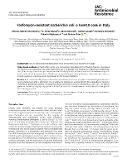Fosfomycin-resistant Escherichia coli: a FosA10 case in Italy

Author
Mattioni Marchetti, Vittoria
Petrizzi, Ilaria
Venturelli, Irene
Publication date
2025Published in
JAC-Antimicrobial ResistanceVolume / Issue
7 (2)ISBN / ISSN
ISSN: 2632-1823ISBN / ISSN
eISSN: 2632-1823Metadata
Show full item recordCollections
This publication has a published version with DOI 10.1093/jacamr/dlaf052
Abstract
BACKGROUND: FosA10-producing Enterobacterales have an extremely low incidence in Europe. PATIENTS AND METHODS: In March 2024, an 83-year-old woman, hospitalized in the Modena Province, developed an infection with fosfomycin-resistant Escherichia coli. The patient was treated with piperacillin/tazobactam and, after 10 days, the clinical picture was resolved. Fosfomycin MIC was evaluated with the reference agar dilution method and the production of FosA enzymes by phenotypic testing. Genomic characterization was assessed using long-read sequencing technology on the Sequel I platform. RESULTS: An E. coli isolate (FO_2) was collected from both blood and urine samples and showed high-level resistance to fosfomycin (MIC > 128 mg/L). The resistance to fosfomycin was ascribed to the production of FosA-like enzymes by phenotypic testing. The genomic analysis pointed to a FosA10-producing E. coli ST69. The fosA10 gene was carried by a highly conjugative IncB/O/K/Z plasmid that showed relevant similarities with other globally circulating plasmids. CONCLUSIONS: The acquisition of rare fosA-like genes in clinically relevant clones is concerning and the dissemination of FosA-producing E. coli should be continuously monitored.
Keywords
Fosfomycin-resistant, Escherichia, coli, FosA10, case, Italy
Permanent link
https://hdl.handle.net/20.500.14178/3129License
Full text of this result is licensed under: Creative Commons Uveďte původ 4.0 International







